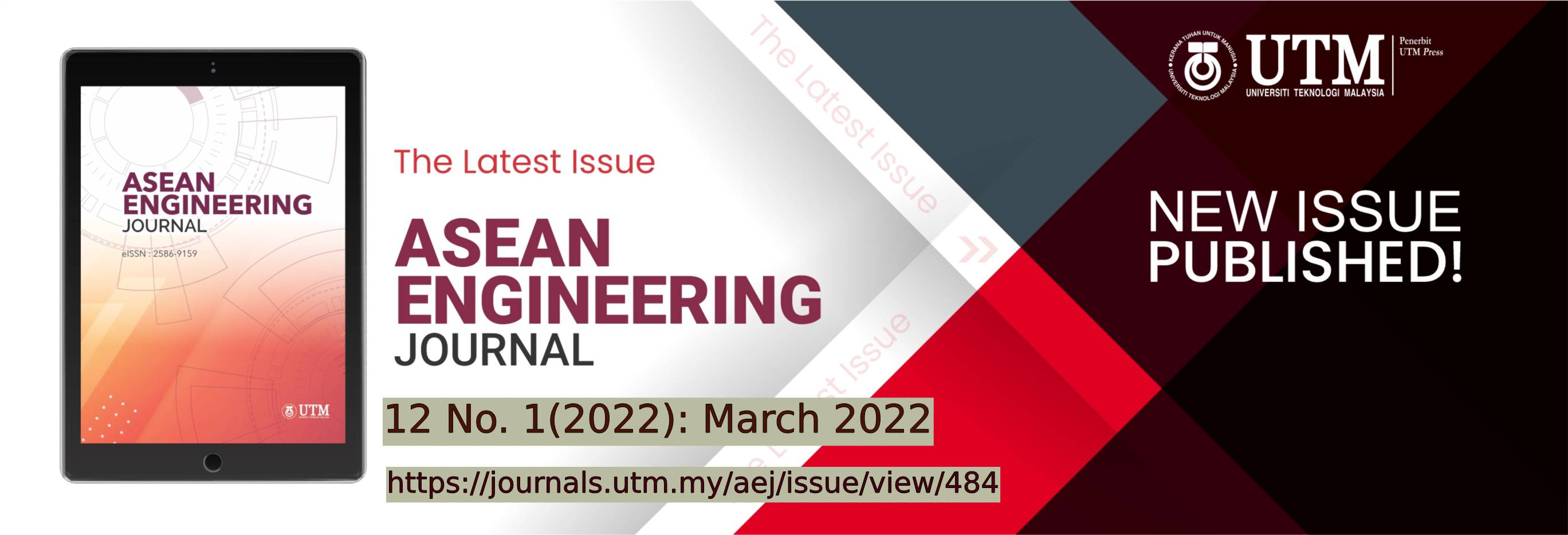SINGLE PILES AND PILE GROUPS CAPACITY IN UNSATURATED SANDY CLAY BASED ON LABORATORY TEST
DOI:
https://doi.org/10.11113/aej.v12.17520Keywords:
Compressive load, Degree of saturation, Matric suction, Pile foundation, Uplift loadAbstract
Pile capacity is one of the controlling factors in the foundation design. In this study, compression and tension tests were carried out on model piles driven in sandy clay in a test box. The diameter of concrete single-pile models was 16 mm, with ratios of 6, 10, 15 and 20 for pile length (L) to diameter (d). The diameter and length of concrete pile group models were 10 mm and 200 mm, respectively, with four different configuration groups, i.e., single pile, two piles (2×1), three piles (triangle), and four piles (2´2). The sandy clay was prepared in three different water contents of 17.40%, 23.44%, and 27.86%. The capacities of the single piles and pile groups subjected to uplift load were smaller than those under compressive load. Increasing the pile length to the ratio of diameter (L/d) and matric suction resulted in increased capacity of single piles subject to uplifting and compressive loads. The pile groups' capacity depended on both the matric suction and the pile number in a group. The pile groups' compressive capacity in a condition of unsaturated soil (with the matric suction of soil of 73.67 kPa) increased by 294.96%-346.39% when compared to those in saturated soil conditions (with the matric suction of soil of 2.727 kPa).
References
Fredlund, D.G., and Rahardjo, H. 1993. Soil mechanics for unsaturated soils, New York, John Wiley & Sons Inc. DOI: https://doi.org/10.1002/9780470172759
Lu, N., and Likos, W.J. 2004. Unsaturated soil mechanics, New York, John Wiley & Sons Inc.
Elsharief, A.M., and Abdulaziz, O.A. 2015. Effects of matric suction on the shear strength of highly plastic compacted clay. In proc. of the 16th African Regional Conf. on Soil Mechanics and Geotechnical Engineering: Innovative Geotechnics for Africa - Bouassida, Khemakhem & Haffoudhi (Eds.), Tunis. 97-103.
Geordiadis, K., Potts, D.M. and Zdravkovic, L. 2003. The influence of partial soil saturation on pile behavior. Géotechnique, 3(1):11–25. DOI: https://doi.org/10.1680/geot.2003.53.1.11
Krishnapillai, H. and Ravichandran, N. 2012. New soil-water characteristic curve and its performance in the finite element simulation of unsaturated soils. ASCE-International Journal of Geomechanics, 12(3):209219. DOI: https://doi.org/10.1061/(ASCE)GM.1943-5622.0000132
Guan, G.S., Rahardjo, H. and Choon, L.E. 2010. Shear strength equations for unsaturated soil under drying and wetting. Journal of Geotechnical and Geoenvironmental Engineering ASCE. 136(4):594606. DOI: https://doi.org/10.1061/(ASCE)GT.1943-5606.0000261
Gallage, C. and Uchimura, T. 2016. Direct shear testing on unsaturated silty soils to investigate the effects of drying and wetting on shear strength parameters at low suction. Journal of Geotechnical and Geoenvironmental Engineering, ASCE, 142(3):1-9. DOI: https://doi.org/10.1061/(ASCE)GT.1943-5606.0001416
Vanapalli, S.K., Fredlund, D.G., Pufahl, D.E. and Clifton, A.W. 1996. Model for the prediction of shear strength with respect to soil suction. Canadian Geotechnical Journal, 33:379–392. DOI: https://doi.org/10.1139/t96-060
Pujiastuti, H., Rifa’i, A., Adi, A.D. and Fathani, T.F. 2018a. The effect of matric suction on the shear strength of unsaturated sandy clay. International Journal of Geomate,14(42):112–119. DOI: https://doi.org/10.21660/2018.42.72825
Fredlund, D.G., Xing, A., Fredlund, M.D. and Barbour, S.L. 1996. The relationship of the unsaturated soil shear strength to the soil-water characteristic curve. Canadian Geotechnical Journal, 33(3):440–448. DOI: https://doi.org/10.1139/t96-065
halili, N. and Khabbaz, M.H. 1998. A unique relationship for χ for the determination of the shear strength of unsaturated soils. Géotechnique, 48(5):681–687. DOI: https://doi.org/10.1680/geot.1998.48.5.681
Vanapalli, S.K. and Fredlund, D.G. 1999. Empirical procedures to predict the shear strength of unsaturated soils. In Proc. of the XI Asian Regional Conf. on Soil Mechanics and Geotechnical Engineering. 93–96.
Gaaver, K.E. 2013. Uplift capacity of single piles and pile groups embedded in cohesionless soil. Alexandria Engineering Journal, 52:365–372. DOI: https://doi.org/10.1016/j.aej.2013.01.003
Jebur, A., Atherton, W. Alkhadar, R.M. and Loffill, E. 2017. Piles in sandy soil: a numerical study and experimental validation. Creative Construction Conference, Procedia Engineering, Primosten, Croatia, June 196:60–67. DOI: https://doi.org/10.1016/j.proeng.2017.07.173
[15] Al-Omari, R.R., Fattah, M.Y. and Kallawi, A.M. 2018. Laboratory study on load carrying capacity of pile group in unsaturated clay. Arabian Journal for Science and Engineering, 44(5):46134627.https://doi.org/10.1007/s13369-018-3483-9
Pujiastuti, H., Rifa’i, A., Adi, A.D and Fathani, T.F. 2018b. Effect of matric suction change on pile foundation capacity in unsaturated soils. International Conference on Geotechnics, Yogyakarta, Indonesia, July 1:94–100.
Chung, S.H. and Yang, S.R. 2017. Numerical analysis of small-scale model pile in unsaturated clayey soil. International Journal of Civil Engineering, 15 :877–886. DOI: https://doi.org/10.1007/s40999-016-0065-7
Pujiastuti, H. 2020. Perilaku fondasi tiang akibat pembebanan pada tanah jenuh sebagian (unsaturated soil). Disertasi. Departemen Teknik Sipil dan Lingkungan, Fakultas Teknik, Universitas Gadjah Mada (UGM), Yogyakarta, Indonesia.
Bolton, M.D., Gui, M.W., Garnier, J., Corte, J.F., Bagge, G., Laue, J. and Renzi, R. 1999. Centrifuge cone penetration tests in sand Géotechnique, 49(4):543–552. DOI: https://doi.org/10.1680/geot.1999.49.4.543
Robinsky, E.I. and Morrison, C.F. 1964. Sand displacement and compaction around model friction piles. Canadian Geotechnical Journal, 1:81–93. DOI: https://doi.org/10.1139/t64-002
ASTM. 2006. Annual Book of ASTM Standards Vol. 04.08, Philadelphia, USA
Tomlinson, M.J. 2004. Pile design and construction practice, 4, London, Taylor & Francis Group e-library.
















